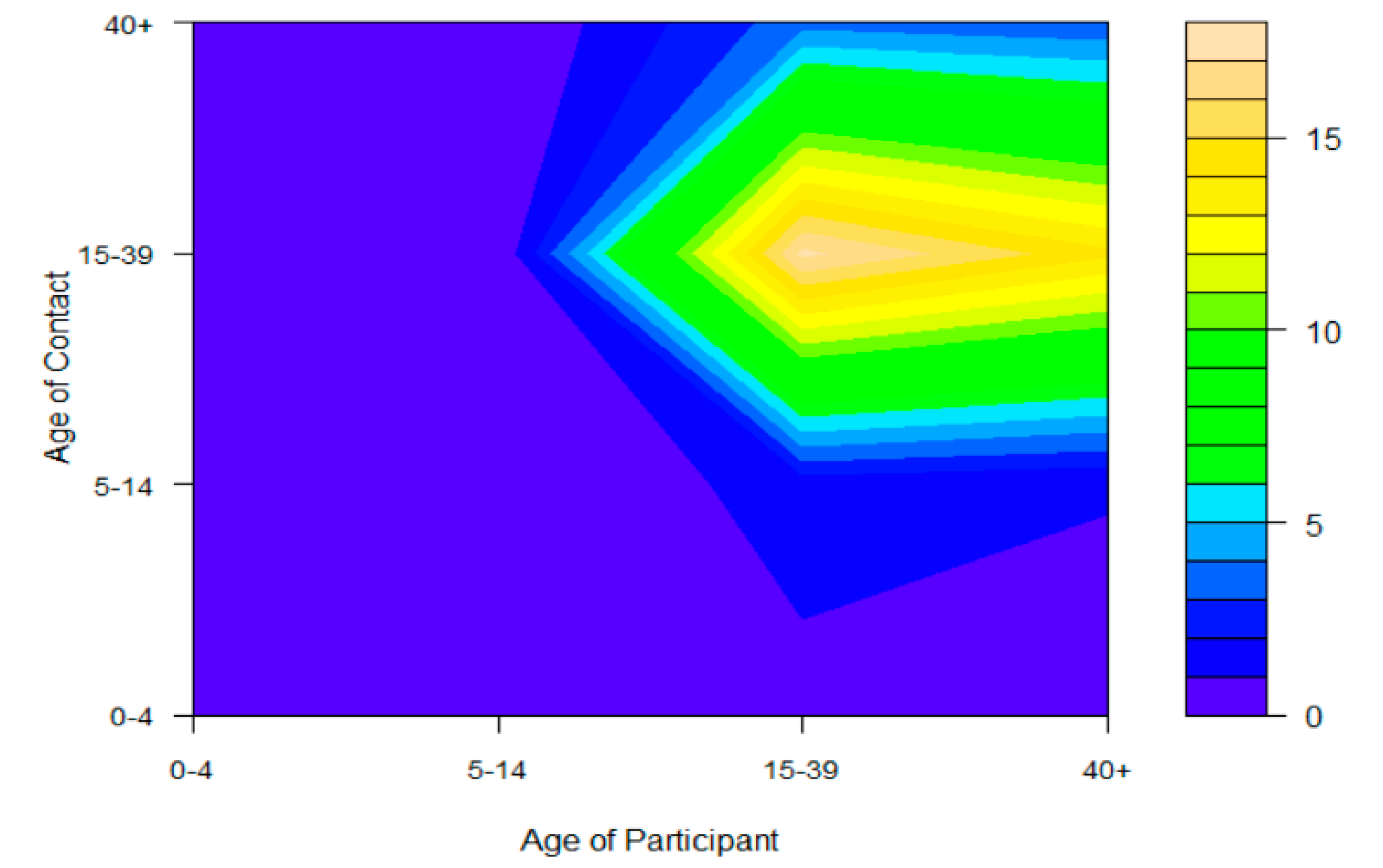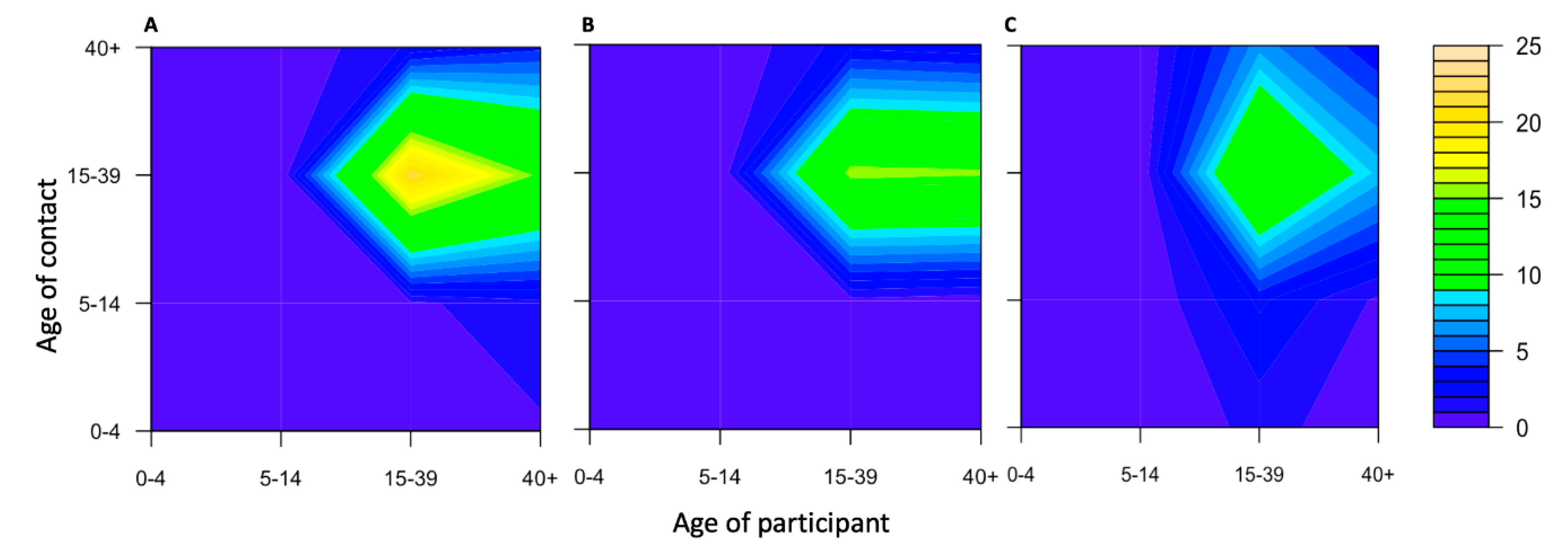Contact Mixing Patterns and Population Movement among Migrant Workers in an Urban Setting in Thailand
Abstract
:1. Introduction
2. Materials and Methods
2.1. Study Area and Data Collection
2.2. Data Analysis
3. Results
4. Discussion
5. Conclusions
Author Contributions
Funding
Acknowledgments
Conflicts of Interest
References
- Del Valle, S.Y.; Hyman, J.M.; Chitnis, N. Mathematical models of contact patterns between age groups for predicting the spread of infectious diseases. Math. Biosci. Eng. 2013, 10, 1475–1497. [Google Scholar] [PubMed]
- Bansal, S.; Grenfell, B.T.; Meyers, L.A. When individual behaviour matters: Homogeneous and network models in epidemiology. J. R. Soc. Interface 2007, 4, 879–891. [Google Scholar] [CrossRef] [PubMed] [Green Version]
- Keeling, M.R.P. Modeling Infectious Diseases in Humans and Animals; Princeton University Press: Princeton, NJ, USA, 2008. [Google Scholar]
- Volz, E.M.; Miller, J.C.; Galvani, A.; Ancel Meyers, L. Effects of heterogeneous and clustered contact patterns on infectious disease dynamics. PLoS Comput. Biol. 2011, 7, e1002042. [Google Scholar] [CrossRef]
- Wu, J.; Dhingra, R.; Gambhir, M.; Remais, J.V. Sensitivity analysis of infectious disease models: Methods, advances and their application. J. R. Soc. Interface 2013, 10, 20121018. [Google Scholar] [CrossRef] [PubMed] [Green Version]
- Aral, S.O. Patterns of sexual mixing: Mechanisms for or limits to the spread of STIs? Sex. Transm. Infect. 2000, 76, 415–416. [Google Scholar] [CrossRef] [PubMed] [Green Version]
- Laumann, E.O.; Youm, Y. Racial/ethnic group differences in the prevalence of sexually transmitted diseases in the United States: A network explanation. Sex. Transm. Dis. 1999, 26, 250–261. [Google Scholar] [CrossRef]
- Youm, Y.; Laumann, E.O. Social network effects on the transmission of sexually transmitted diseases. Sex. Transm. Dis. 2002, 29, 689–697. [Google Scholar] [CrossRef]
- Datta, S.; Mercer, C.H.; Keeling, M.J. Capturing sexual contact patterns in modelling the spread of sexually transmitted infections: Evidence using Natsal-3. PLoS ONE 2018, 13, e0206501. [Google Scholar] [CrossRef]
- Mossong, J.; Hens, N.; Jit, M.; Beutels, P.; Auranen, K.; Mikolajczyk, R.; Massari, M.; Salmaso, S.; Tomba, G.S.; Wallinga, J.; et al. Social contacts and mixing patterns relevant to the spread of infectious diseases. PLoS Med. 2008, 5, e74. [Google Scholar] [CrossRef]
- Wallinga, J.; Teunis, P.; Kretzschmar, M. Using data on social contacts to estimate age-specific transmission parameters for respiratory-spread infectious agents. Am. J. Epidemiol. 2006, 164, 936–944. [Google Scholar] [CrossRef]
- Meeyai, A.; Praditsitthikorn, N.; Kotirum, S.; Kulpeng, W.; Putthasri, W.; Cooper, B.S.; Teerawattananon, Y. Seasonal influenza vaccination for children in Thailand: A cost-effectiveness analysis. PLoS Med. 2015, 12, e1001829. [Google Scholar] [CrossRef] [PubMed]
- Horby, P.; Pham, Q.T.; Hens, N.; Nguyen, T.T.; Le, Q.M.; Dang, D.T.; Nguyen, M.L.; Nguyen, T.H.; Alexander, N.; Edmunds, W.J.; et al. Social contact patterns in Vietnam and implications for the control of infectious diseases. PLoS ONE 2011, 6, e16965. [Google Scholar] [CrossRef] [PubMed]
- Le Polain de Waroux, O.; Cohuet, S.; Ndazima, D.; Kucharski, A.J.; Juan-Giner, A.; Flasche, S.; Tumwesigye, E.; Arinaitwe, R.; Mwanga-Amumpaire, J.; Boum, Y., 2nd; et al. Characteristics of human encounters and social mixing patterns relevant to infectious diseases spread by close contact: A survey in Southwest Uganda. BMC Infect. Dis. 2018, 18, 172. [Google Scholar] [CrossRef] [PubMed]
- Prem, K.; Cook, A.R.; Jit, M. Projecting social contact matrices in 152 countries using contact surveys and demographic data. PLoS Comput. Biol. 2017, 13, e1005697. [Google Scholar] [CrossRef] [PubMed]
- Munasinghe, L.; Asai, Y.; Nishiura, H. Quantifying heterogeneous contact patterns in Japan: A social contact survey. Theor. Biol. Med. Model. 2019, 16, 6. [Google Scholar] [CrossRef]
- Stein, M.L.; van Steenbergen, J.E.; Buskens, V.; van der Heijden, P.G.; Chanyasanha, C.; Tipayamongkholgul, M.; Thorson, A.E.; Bengtsson, L.; Lu, X.; Kretzschmar, M.E. Comparison of contact patterns relevant for transmission of respiratory pathogens in Thailand and The Netherlands using respondent-driven sampling. PLoS ONE 2014, 9, e113711. [Google Scholar] [CrossRef]
- Khamsiriwatchara, A.; Wangroongsarb, P.; Thwing, J.; Eliades, J.; Satimai, W.; Delacollette, C.; Kaewkungwal, J. Respondent-driven sampling on the Thailand-Cambodia border. I. Can malaria cases be contained in mobile migrant workers? Malar. J. 2011, 10, 120. [Google Scholar] [CrossRef] [Green Version]
- Department Of Employment. Statistics Journal of the Number of Aliens in Thailand; Foreign Workers Administration Office: Bangkok, Thailand, 2015. [Google Scholar]
- International Labour Organization. Thailand—A Labour Market Profile; ILO Regional Office for Asia and the Pacific Bangkok: Bangkok, Thailand, 2013. [Google Scholar]
- Hilbe, J. Negative Binomial Regression; Cambridge University Press: Cambridge, UK, 2007. [Google Scholar]
- Ferguson, N.M.; Cummings, D.A.; Fraser, C.; Cajka, J.C.; Cooley, P.C.; Burke, D.S. Strategies for mitigating an influenza pandemic. Nature 2006, 442, 448–452. [Google Scholar] [CrossRef]
- Eubank, S.; Guclu, H.; Kumar, V.S.; Marathe, M.V.; Srinivasan, A.; Toroczkai, Z.; Wang, N. Modelling disease outbreaks in realistic urban social networks. Nature 2004, 429, 180–184. [Google Scholar] [CrossRef]
- Goeyvaerts, N.; Santermans, E.; Potter, G.; Torneri, A.; Van Kerckhove, K.; Willem, L.; Aerts, M.; Beutels, P.; Hens, N. Household members do not contact each other at random: Implications for infectious disease modelling. Proc. Biol. Sci. 2018, 285, 20182201. [Google Scholar] [CrossRef] [Green Version]
- Marziano, V.; Poletti, P.; Beraud, G.; Boelle, P.Y.; Merler, S.; Colizza, V. Modeling the impact of changes in day-care contact patterns on the dynamics of varicella transmission in France between 1991 and 2015. PLoS Comput. Biol. 2018, 14, e1006334. [Google Scholar] [CrossRef] [PubMed]
- Ajelli, M.; Litvinova, M. Estimating contact patterns relevant to the spread of infectious diseases in Russia. J. Theor. Biol. 2017, 419, 1–7. [Google Scholar] [CrossRef] [PubMed]
- Leung, K.; Jit, M.; Lau, E.H.Y.; Wu, J.T. Social contact patterns relevant to the spread of respiratory infectious diseases in Hong Kong. Sci. Rep. 2017, 7, 7974. [Google Scholar] [CrossRef] [PubMed]
- Melegaro, A.; Del Fava, E.; Poletti, P.; Merler, S.; Nyamukapa, C.; Williams, J.; Gregson, S.; Manfredi, P. Social Contact Structures and Time Use Patterns in the Manicaland Province of Zimbabwe. PLoS ONE 2017, 12, e0170459. [Google Scholar] [CrossRef] [Green Version]
- Chaisuparakul, S. Life and Community of Cambodian Migrant Workers in Thai Society. J. Popul. Soc. Stud. 2015, 23, 2–16. [Google Scholar]
- Mistry, D.; Litvinova, M.; Pastore y Piontti, A.; Chinazzi, M.; Fumanelli, L.; Gomes, M.; Haque, S.; Liu, Q.; Mu, K.; Xiong, X.; et al. Inferring high-resolution human mixing patterns for disease modeling. arXiv 2020, arXiv:2003.01214. [Google Scholar]




| Myanmar | Cambodia | Laos PDR | Overall | |
|---|---|---|---|---|
| Demographics | ||||
| Total number of participants | 128 | 135 | 106 | 369 |
| Mean age (SD) | 28.95 (7.90) | 29.34 (6.22) | 26.95 (7.16) | 28.52 (7.16) |
| Minimum age | 15 | 18 | 16 | 15 |
| Maximum age | 52 | 49 | 59 | 59 |
| Male (%) | 63.28 | 54.07 | 23.58 | 48.51 |
| Primary school only (%) | 33.59 | 46.67 | 54.72 | 50.14 |
| Daily wage in THB (SD) | 315.87 (54.98) | 304.73 (27.81) | 360.57 (76.68) | 323.02 (58.19) |
| General labor (%) | 87.50 | 90.37 | 77.36 | 91.33 |
| Type of work | ||||
| Food factory (%) | 23.44 | 49.67 | 0 | 25.20 |
| Private home (%) | 0 | 0 | 16.03 | 4.61 |
| Market (%) | 25.00 | 22.96 | 83.94 | 41.19 |
| Other kinds of factories (%) | 51.56 | 30.37 | 0 | 29.00 |
| Population movement | ||||
| One day off per week (%) | 72.66 | 64.44 | 19.81 | 54.47 |
| Return home every year (%) | 25.78 | 77.78 | 44.34 | 50.14 |
| Myanmar | Cambodia | Laos PDR | Overall | |
|---|---|---|---|---|
| Total contacts | 3128 | 2574 | 2654 | 8356 |
| Contact with males (%) | 64.87 | 55.83 | 45.48 | 55.92 |
| Physical contacts (%) | 37.79 | 26.92 | 17.75 | 28.07 |
| Mean number of contacts/person (SD) | 16.19 (11.61) | 12.62 (9.40) | 15.68 (11.35) | 14.93 (11.00) |
| Number of contacts aged less than 5 years | 59 | 53 | 137 | 249 |
| Number of contacts aged 5 to 14 years | 117 | 81 | 326 | 542 |
| Number of contacts aged 15 to 40 years | 2469 | 2109 | 1518 | 6276 |
| Number of contacts aged more than 40 years | 303 | 331 | 673 | 1307 |
| Contacts at home (%) | 42.39 | 40.95 | 28.15 | 37.42 |
| Contacts at work (%) | 67.30 | 56.06 | 68.61 | 64.25 |
| Contacts in other places (%) | 8.31 | 7.78 | 12.17 | 9.37 |
| Category | Number of Participants | Mean (Standard Deviation) Number of Reported Contacts | Relative Number of Reported Contacts (95% Confidence Intervals) |
|---|---|---|---|
| Gender | |||
| Male | 179 | 22.37 (13.02) | 1 |
| Female | 190 | 22.89 (10.70) | 1.01 (0.89–1.13) |
| Age | |||
| 0–20 | 54 | 24 (13.29) | 1 |
| 21–40 | 292 | 22.69 (11.67) | 0.99 (0.86–1.16) |
| >40 | 23 | 18.78 (10.55) | 0.82 (0.64–1.06) |
| Nationality | |||
| Myanmar | 128 | 24.43 (13.07) | 1 |
| Cambodia | 135 | 19.06 (9.96) | 0.76 (0.66–0.87) * |
| Laos | 106 | 25.03 (11.60) | 1.09 (0.90–1.31) |
| Type of work | |||
| Food factory | 93 | 22.39 (12.38) | 1 |
| Market | 152 | 23.55 (11.82) | 0.92 (0.77–1.10) |
| Private home and Others | 124 | 21.71 (11.55) | 0.98 (0.84–1.14) |
| Education | |||
| Primary school | 164 | 22.39 (11.86) | 1 |
| High school | 155 | 23.49 (11.91) | 1.08 (0.96–1.21) |
| Undergraduate | 27 | 20.77 (12.78) | 0.92 (0.74–1.15) |
| Postgraduate | 2 | 17.5 (0.70) | 0.89 (0.43–1.84) |
| Unknown | 21 | 21.23 (11.21) | 0.58 (0.34–1.01) |
| Occupation | |||
| General labor | 316 | 22.06 (11.64) | 1 |
| Merchant | 18 | 24.61 (10.80) | 1.23 (0.95–1.58) |
| Agricultural worker | 11 | 36.90 (12.89) | 1.59 (1.17–2.16) * |
| Other | 3 | 29.66 (13.86) | 1.24 (0.70–2.21) |
| Unknown | 21 | 21.23 (11.21) | 0.58 (0.34–1.01) |
| Income per day | |||
| Less than 300 baht | 239 | 21.94 (11.71) | 1 |
| 300 baht or more | 104 | 24.39 (12.35) | 1.07 (0.94–1.23) |
| Unknown | 26 | 22.07 (11.11) | 1.47 (0.93–2.32) |
© 2020 by the authors. Licensee MDPI, Basel, Switzerland. This article is an open access article distributed under the terms and conditions of the Creative Commons Attribution (CC BY) license (http://creativecommons.org/licenses/by/4.0/).
Share and Cite
Mahikul, W.; Kripattanapong, S.; Hanvoravongchai, P.; Meeyai, A.; Iamsirithaworn, S.; Auewarakul, P.; Pan-ngum, W. Contact Mixing Patterns and Population Movement among Migrant Workers in an Urban Setting in Thailand. Int. J. Environ. Res. Public Health 2020, 17, 2237. https://0-doi-org.brum.beds.ac.uk/10.3390/ijerph17072237
Mahikul W, Kripattanapong S, Hanvoravongchai P, Meeyai A, Iamsirithaworn S, Auewarakul P, Pan-ngum W. Contact Mixing Patterns and Population Movement among Migrant Workers in an Urban Setting in Thailand. International Journal of Environmental Research and Public Health. 2020; 17(7):2237. https://0-doi-org.brum.beds.ac.uk/10.3390/ijerph17072237
Chicago/Turabian StyleMahikul, Wiriya, Somkid Kripattanapong, Piya Hanvoravongchai, Aronrag Meeyai, Sopon Iamsirithaworn, Prasert Auewarakul, and Wirichada Pan-ngum. 2020. "Contact Mixing Patterns and Population Movement among Migrant Workers in an Urban Setting in Thailand" International Journal of Environmental Research and Public Health 17, no. 7: 2237. https://0-doi-org.brum.beds.ac.uk/10.3390/ijerph17072237







